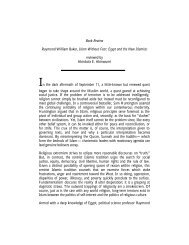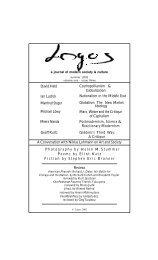Michael J. Thompson Stephen Eric Bronner Wadood Hamad - Logos
Michael J. Thompson Stephen Eric Bronner Wadood Hamad - Logos
Michael J. Thompson Stephen Eric Bronner Wadood Hamad - Logos
You also want an ePaper? Increase the reach of your titles
YUMPU automatically turns print PDFs into web optimized ePapers that Google loves.
Abbas Amanat<br />
of the imam” (na’ib-i imam), more in vogue in the 19th century, in practice a<br />
consensus was reached on the universal and sole reference of the term imam<br />
to the founder of the Islamic Republic, hence “Imam Khomeini.”<br />
The constitutional authority and popular aura that Khomeini acquired as the<br />
guardian jurist, denoted not only a desire for rationalization of the clerical<br />
community but also a drive toward clerical absolutism. The legitimacy and<br />
the mandate of the guardian jurist does not derive from his constituency of<br />
followers, as in the case of the marja’, but from a sublime source. Despite the<br />
seemingly democratic trappings of the constitution of the Islamic Republic,<br />
the guardian jurist is answerable to no source but God, even though he is<br />
appointed by a Council of the Experts (Majlis-i Khubragan), a select body of<br />
high-ranking ’ulama (and presumably impeachable by the same body). The<br />
range of the guardian’s institutional authority is vast and universally abiding<br />
even though the Islamic Consultative Council (Majlis-i Shawra-yi Islami; i.e.,<br />
the parliament) tends to modify his ultimate power. Similarly, articles of the<br />
Constitution guaranteeing the inalienable rights and freedoms of the<br />
individual contradict with the authoritarian power of the guardian jurist.<br />
Khomeini’s charismatic aura in early years of the revolution glossed over the<br />
obvious contradiction in the constitution between democratic freedoms and<br />
the totalitarian power of the guardian jurist. In post-Khomeini era, and<br />
twenty-three years after the revolution, the contrast is glaring. The “supreme<br />
leader” (rahbar) as Khomeini’s successor, Ayatollah ’Ali Khamanei is<br />
recognized in today’s Islamic Republic, insists on these constitutional<br />
prerogatives to control, and if necessary quell, the legislative, the executive<br />
and the judicial branches of the government and remain unaccountable to<br />
any elected body.<br />
The authoritarian nature of wilayat-i faqih is indebted to the persistent<br />
culture of autocracy which the revolution denounced in theory but<br />
perpetuated in practice. But it also was reflective of the Shi’ite judicial<br />
community’s failure to rethink the precepts of the Shi’ite law and their<br />
applicability to pluralist values. The doctrine of the “guardianship of the<br />
jurist” was informed above all by a Shi’ite legal mindset that essentially was<br />
alien to the modern notions of plurality and democratic leadership even<br />
though, ironically, Shi’ite ijtihad and marja’iya operated on some form of<br />
popular representation. It was also colored, no doubt, by Khomeini’s own<br />
mystical propensity for classical Sufism and specifically Ibn ’Arabi’s theory of<br />
wilaya. Moreover, what historically informed “guardianship,” as apparent in<br />
the rhetoric of the Islamic revolution, was an imagined narrative of Islam’s<br />
<strong>Logos</strong> 2.3 – Summer 2003




